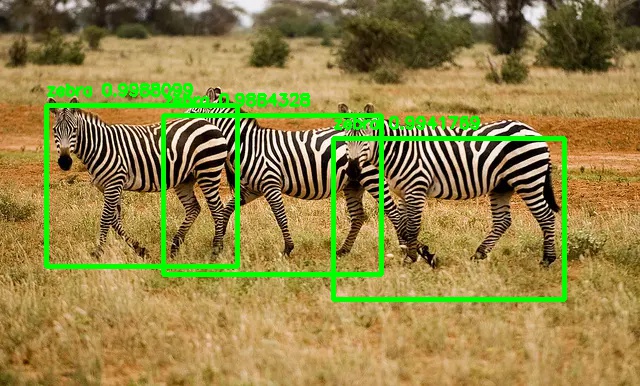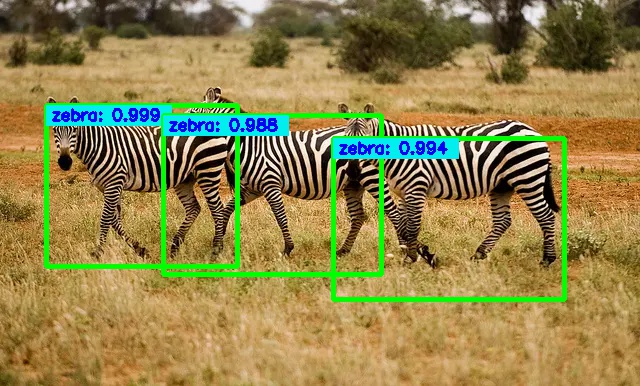本文目的:介绍一篇YOLO3的Keras实现项目,便于快速了解如何使用预训练的YOLOv3,来对新图像进行目标检测。
本文使用的是Github上一位大神训练的YOLO3开源的项目。这个项目提供了很多使用 YOLOv3 的模型,包括对象检测、迁移学习、从头开始训练模型等。其中提供了一个脚本文件yolo3_one_file_to_detect_them_all.py,作者表示单独运行即可进行目标检测。
但是经过测试,还是有几个坑。所以我把代码分解成几个功能模块,在jupyter notebook上单独运行,查出bug后,即可正常运行。
本文操作十分方便,直接下载权重文件,将后面三部分代码拷贝至jupyter notebook运行即可(前提是需要安装库numpy、Keras、cv2),不需要其他的脚本文件。
第一步:下载权重文件 https://pjreddie.com/media/files/yolov3.weights
这个权重是在MS COCO上训练的结果,因此可以检测80种目标。
第二步:导入需要的库函数,以及后续待用的函数
import argparse
import os
import numpy as np
from keras.layers import Conv2D, Input, BatchNormalization, LeakyReLU, ZeroPadding2D, UpSampling2D
from keras.layers.merge import add, concatenate
from keras.models import Model
import struct
import cv2
#改动1:这里报错,和我机器不一致,所以注释掉
#np.set_printoptions(threshold=np.nan)
#os.environ["CUDA_DEVICE_ORDER"]="PCI_BUS_ID"
#os.environ["CUDA_VISIBLE_DEVICES"]="0"
argparser = argparse.ArgumentParser(
description='test yolov3 network with coco weights')
argparser.add_argument(
'-w',
'--weights',
help='path to weights file')
argparser.add_argument(
'-i',
'--image',
help='path to image file')
class WeightReader:
def __init__(self, weight_file):
with open(weight_file, 'rb') as w_f:
major, = struct.unpack('i', w_f.read(4))
minor, = struct.unpack('i', w_f.read(4))
revision, = struct.unpack('i', w_f.read(4))
if (major*10 + minor) >= 2 and major < 1000 and minor < 1000:
w_f.read(8)
else:
w_f.read(4)
transpose = (major > 1000) or (minor > 1000)
binary = w_f.read()
self.offset = 0
self.all_weights = np.frombuffer(binary, dtype='float32')
def read_bytes(self, size):
self.offset = self.offset + size
return self.all_weights[self.offset-size:self.offset]
def load_weights(self, model):
for i in range(106):
try:
conv_layer = model.get_layer('conv_' + str(i))
print("loading weights of convolution #" + str(i))
if i not in [81, 93, 105]:
norm_layer = model.get_layer('bnorm_' + str(i))
size = np.prod(norm_layer.get_weights()[0].shape)
beta = self.read_bytes(size) # bias
gamma = self.read_bytes(size) # scale
mean = self.read_bytes(size) # mean
var = self.read_bytes(size) # variance
weights = norm_layer.set_weights([gamma, beta, mean, var])
if len(conv_layer.get_weights()) > 1:
bias = self.read_bytes(np.prod(conv_layer.get_weights()[1].shape))
kernel = self.read_bytes(np.prod(conv_layer.get_weights()[0].shape))
kernel = kernel.reshape(list(reversed(conv_layer.get_weights()[0].shape)))
kernel = kernel.transpose([2,3,1,0])
conv_layer.set_weights([kernel, bias])
else:
kernel = self.read_bytes(np.prod(conv_layer.get_weights()[0].shape))
kernel = kernel.reshape(list(reversed(conv_layer.get_weights()[0].shape)))
kernel = kernel.transpose([2,3,1,0])
conv_layer.set_weights([kernel])
except ValueError:
print("no convolution #" + str(i))
def reset(self):
self.offset = 0
class BoundBox:
def __init__(self, xmin, ymin, xmax, ymax, objness = None, classes = None):
self.xmin = xmin
self.ymin = ymin
self.xmax = xmax
self.ymax = ymax
self.objness = objness
self.classes = classes
self.label = -1
self.score = -1
def get_label(self):
if self.label == -1:
self.label = np.argmax(self.classes)
return self.label
def get_score(self):
if self.score == -1:
self.score = self.classes[self.get_label()]
return self.score
def _conv_block(inp, convs, skip=True):
x = inp
count = 0
for conv in convs:
if count == (len(convs) - 2) and skip:
skip_connection = x
count += 1
if conv['stride'] > 1: x = ZeroPadding2D(((1,0),(1,0)))(x) # peculiar padding as darknet prefer left and top
x = Conv2D(conv['filter'],
conv['kernel'],
strides=conv['stride'],
padding='valid' if conv['stride'] > 1 else 'same', # peculiar padding as darknet prefer left and top
name='conv_' + str(conv['layer_idx']),
use_bias=False if conv['bnorm'] else True)(x)
if conv['bnorm']: x = BatchNormalization(epsilon=0.001, name='bnorm_' + str(conv['layer_idx']))(x)
if conv['leaky']: x = LeakyReLU(alpha=0.1, name='leaky_' + str(conv['layer_idx']))(x)
return add([skip_connection, x]) if skip else x
def _interval_overlap(interval_a, interval_b):
x1, x2 = interval_a
x3, x4 = interval_b
if x3 < x1:
if x4 < x1:
return 0
else:
return min(x2,x4) - x1
else:
if x2 < x3:
return 0
else:
return min(x2,x4) - x3
def _sigmoid(x):
return 1. / (1. + np.exp(-x))
def bbox_iou(box1, box2):
intersect_w = _interval_overlap([box1.xmin, box1.xmax], [box2.xmin, box2.xmax])
intersect_h = _interval_overlap([box1.ymin, box1.ymax], [box2.ymin, box2.ymax])
intersect = intersect_w * intersect_h
w1, h1 = box1.xmax-box1.xmin, box1.ymax-box1.ymin
w2, h2 = box2.xmax-box2.xmin, box2.ymax-box2.ymin
union = w1*h1 + w2*h2 - intersect
return float(intersect) / union
def make_yolov3_model():
input_image = Input(shape=(None, None, 3))
# Layer 0 => 4
x = _conv_block(input_image, [{'filter': 32, 'kernel': 3, 'stride': 1, 'bnorm': True, 'leaky': True, 'layer_idx': 0},
{'filter': 64, 'kernel': 3, 'stride': 2, 'bnorm': True, 'leaky': True, 'layer_idx': 1},
{'filter': 32, 'kernel': 1, 'stride': 1, 'bnorm': True, 'leaky': True, 'layer_idx': 2},
{'filter': 64, 'kernel': 3, 'stride': 1, 'bnorm': True, 'leaky': True, 'layer_idx': 3}])
# Layer 5 => 8
x = _conv_block(x, [{'filter': 128, 'kernel': 3, 'stride': 2, 'bnorm': True, 'leaky': True, 'layer_idx': 5},
{'filter': 64, 'kernel': 1, 'stride': 1, 'bnorm': True, 'leaky': True, 'layer_idx': 6},
{'filter': 128, 'kernel': 3, 'stride': 1, 'bnorm': True, 'leaky': True, 'layer_idx': 7}])
# Layer 9 => 11
x = _conv_block(x, [{'filter': 64, 'kernel': 1, 'stride': 1, 'bnorm': True, 'leaky': True, 'layer_idx': 9},
{'filter': 128, 'kernel': 3, 'stride': 1, 'bnorm': True, 'leaky': True, 'layer_idx': 10}])
# Layer 12 => 15
x = _conv_block(x, [{'filter': 256, 'kernel': 3, 'stride': 2, 'bnorm': True, 'leaky': True, 'layer_idx': 12},
{'filter': 128, 'kernel': 1, 'stride': 1, 'bnorm': True, 'leaky': True, 'layer_idx': 13},
{'filter': 256, 'kernel': 3, 'stride': 1, 'bnorm': True, 'leaky': True, 'layer_idx': 14}])
# Layer 16 => 36
for i in range(7):
x = _conv_block(x, [{'filter': 128, 'kernel': 1, 'stride': 1, 'bnorm': True, 'leaky': True, 'layer_idx': 16+i*3},
{'filter': 256, 'kernel': 3, 'stride': 1, 'bnorm': True, 'leaky': True, 'layer_idx': 17+i*3}])
skip_36 = x
# Layer 37 => 40
x = _conv_block(x, [{'filter': 512, 'kernel': 3, 'stride': 2, 'bnorm': True, 'leaky': True, 'layer_idx': 37},
{'filter': 256, 'kernel': 1, 'stride': 1, 'bnorm': True, 'leaky': True, 'layer_idx': 38},
{'filter': 512, 'kernel': 3, 'stride': 1, 'bnorm': True, 'leaky': True, 'layer_idx': 39}])
# Layer 41 => 61
for i in range(7):
x = _conv_block(x, [{'filter': 256, 'kernel': 1, 'stride': 1, 'bnorm': True, 'leaky': True, 'layer_idx': 41+i*3},
{'filter': 512, 'kernel': 3, 'stride': 1, 'bnorm': True, 'leaky': True, 'layer_idx': 42+i*3}])
skip_61 = x
# Layer 62 => 65
x = _conv_block(x, [{'filter': 1024, 'kernel': 3, 'stride': 2, 'bnorm': True, 'leaky': True, 'layer_idx': 62},
{'filter': 512, 'kernel': 1, 'stride': 1, 'bnorm': True, 'leaky': True, 'layer_idx': 63},
{'filter': 1024, 'kernel': 3, 'stride': 1, 'bnorm': True, 'leaky': True, 'layer_idx': 64}])
# Layer 66 => 74
for i in range(3):
x = _conv_block(x, [{'filter': 512, 'kernel': 1, 'stride': 1, 'bnorm': True, 'leaky': True, 'layer_idx': 66+i*3},
{'filter': 1024, 'kernel': 3, 'stride': 1, 'bnorm': True, 'leaky': True, 'layer_idx': 67+i*3}])
# Layer 75 => 79
x = _conv_block(x, [{'filter': 512, 'kernel': 1, 'stride': 1, 'bnorm': True, 'leaky': True, 'layer_idx': 75},
{'filter': 1024, 'kernel': 3, 'stride': 1, 'bnorm': True, 'leaky': True, 'layer_idx': 76},
{'filter': 512, 'kernel': 1, 'stride': 1, 'bnorm': True, 'leaky': True, 'layer_idx': 77},
{'filter': 1024, 'kernel': 3, 'stride': 1, 'bnorm': True, 'leaky': True, 'layer_idx': 78},
{'filter': 512, 'kernel': 1, 'stride': 1, 'bnorm': True, 'leaky': True, 'layer_idx': 79}], skip=False)
# Layer 80 => 82
yolo_82 = _conv_block(x, [{'filter': 1024, 'kernel': 3, 'stride': 1, 'bnorm': True, 'leaky': True, 'layer_idx': 80},
{'filter': 255, 'kernel': 1, 'stride': 1, 'bnorm': False, 'leaky': False, 'layer_idx': 81}], skip=False)
# Layer 83 => 86
x = _conv_block(x, [{'filter': 256, 'kernel': 1, 'stride': 1, 'bnorm': True, 'leaky': True, 'layer_idx': 84}], skip=False)
x = UpSampling2D(2)(x)
x = concatenate([x, skip_61])
# Layer 87 => 91
x = _conv_block(x, [{'filter': 256, 'kernel': 1, 'stride': 1, 'bnorm': True, 'leaky': True, 'layer_idx': 87},
{'filter': 512, 'kernel': 3, 'stride': 1, 'bnorm': True, 'leaky': True, 'layer_idx': 88},
{'filter': 256, 'kernel': 1, 'stride': 1, 'bnorm': True, 'leaky': True, 'layer_idx': 89},
{'filter': 512, 'kernel': 3, 'stride': 1, 'bnorm': True, 'leaky': True, 'layer_idx': 90},
{'filter': 256, 'kernel': 1, 'stride': 1, 'bnorm': True, 'leaky': True, 'layer_idx': 91}], skip=False)
# Layer 92 => 94
yolo_94 = _conv_block(x, [{'filter': 512, 'kernel': 3, 'stride': 1, 'bnorm': True, 'leaky': True, 'layer_idx': 92},
{'filter': 255, 'kernel': 1, 'stride': 1, 'bnorm': False, 'leaky': False, 'layer_idx': 93}], skip=False)
# Layer 95 => 98
x = _conv_block(x, [{'filter': 128, 'kernel': 1, 'stride': 1, 'bnorm': True, 'leaky': True, 'layer_idx': 96}], skip=False)
x = UpSampling2D(2)(x)
x = concatenate([x, skip_36])
# Layer 99 => 106
yolo_106 = _conv_block(x, [{'filter': 128, 'kernel': 1, 'stride': 1, 'bnorm': True, 'leaky': True, 'layer_idx': 99},
{'filter': 256, 'kernel': 3, 'stride': 1, 'bnorm': True, 'leaky': True, 'layer_idx': 100},
{'filter': 128, 'kernel': 1, 'stride': 1, 'bnorm': True, 'leaky': True, 'layer_idx': 101},
{'filter': 256, 'kernel': 3, 'stride': 1, 'bnorm': True, 'leaky': True, 'layer_idx': 102},
{'filter': 128, 'kernel': 1, 'stride': 1, 'bnorm': True, 'leaky': True, 'layer_idx': 103},
{'filter': 256, 'kernel': 3, 'stride': 1, 'bnorm': True, 'leaky': True, 'layer_idx': 104},
{'filter': 255, 'kernel': 1, 'stride': 1, 'bnorm': False, 'leaky': False, 'layer_idx': 105}], skip=False)
model = Model(input_image, [yolo_82, yolo_94, yolo_106])
return model
def preprocess_input(image, net_h, net_w):
new_h, new_w, _ = image.shape
# determine the new size of the image
if (float(net_w)/new_w) < (float(net_h)/new_h):
new_h = (new_h * net_w)/new_w
new_w = net_w
else:
new_w = (new_w * net_h)/new_h
new_h = net_h
# resize the image to the new size
resized = cv2.resize(image[:,:,::-1]/255., (int(new_w), int(new_h)))
# embed the image into the standard letter box
new_image = np.ones((net_h, net_w, 3)) * 0.5
#改动2:下面有个坑,源代码中new_h可能会出现小数截断之后不匹配问题,所以提前截断
#new_image[int((net_h-new_h)//2):int((net_h+new_h)//2), int((net_w-new_w)//2):int((net_w+new_w)//2), :] = resized
new_image[int((net_h-int(new_h))//2):int((net_h+int(new_h))//2), int((net_w-int(new_w))//2):int((net_w+int(new_w))//2), :] = resized
new_image = np.expand_dims(new_image, 0)
return new_image
def decode_netout(netout, anchors, obj_thresh, nms_thresh, net_h, net_w):
grid_h, grid_w = netout.shape[:2]
nb_box = 3
netout = netout.reshape((grid_h, grid_w, nb_box, -1))
nb_class = netout.shape[-1] - 5
boxes = []
netout[..., :2] = _sigmoid(netout[..., :2])
netout[..., 4:] = _sigmoid(netout[..., 4:])
netout[..., 5:] = netout[..., 4][..., np.newaxis] * netout[..., 5:]
netout[..., 5:] *= netout[..., 5:] > obj_thresh
for i in range(grid_h*grid_w):
row = i / grid_w
col = i % grid_w
for b in range(nb_box):
# 4th element is objectness score
objectness = netout[int(row)][int(col)][b][4]
#objectness = netout[..., :4]
if(objectness.all() <= obj_thresh): continue
# first 4 elements are x, y, w, and h
x, y, w, h = netout[int(row)][int(col)][b][:4]
x = (col + x) / grid_w # center position, unit: image width
y = (row + y) / grid_h # center position, unit: image height
w = anchors[2 * b + 0] * np.exp(w) / net_w # unit: image width
h = anchors[2 * b + 1] * np.exp(h) / net_h # unit: image height
# last elements are class probabilities
classes = netout[int(row)][col][b][5:]
box = BoundBox(x-w/2, y-h/2, x+w/2, y+h/2, objectness, classes)
#box = BoundBox(x-w/2, y-h/2, x+w/2, y+h/2, None, classes)
boxes.append(box)
return boxes
def correct_yolo_boxes(boxes, image_h, image_w, net_h, net_w):
if (float(net_w)/image_w) < (float(net_h)/image_h):
new_w = net_w
new_h = (image_h*net_w)/image_w
else:
new_h = net_w
new_w = (image_w*net_h)/image_h
for i in range(len(boxes)):
x_offset, x_scale = (net_w - new_w)/2./net_w, float(new_w)/net_w
y_offset, y_scale = (net_h - new_h)/2./net_h, float(new_h)/net_h
boxes[i].xmin = int((boxes[i].xmin - x_offset) / x_scale * image_w)
boxes[i].xmax = int((boxes[i].xmax - x_offset) / x_scale * image_w)
boxes[i].ymin = int((boxes[i].ymin - y_offset) / y_scale * image_h)
boxes[i].ymax = int((boxes[i].ymax - y_offset) / y_scale * image_h)
def do_nms(boxes, nms_thresh):
if len(boxes) > 0:
nb_class = len(boxes[0].classes)
else:
return
for c in range(nb_class):
sorted_indices = np.argsort([-box.classes[c] for box in boxes])
for i in range(len(sorted_indices)):
index_i = sorted_indices[i]
if boxes[index_i].classes[c] == 0: continue
for j in range(i+1, len(sorted_indices)):
index_j = sorted_indices[j]
if bbox_iou(boxes[index_i], boxes[index_j]) >= nms_thresh:
boxes[index_j].classes[c] = 0
def draw_boxes(image, boxes, labels, obj_thresh):
for box in boxes:
label_str = ''
label = -1
for i in range(len(labels)):
if box.classes[i] > obj_thresh:
label_str += labels[i]
label = i
print(labels[i] + ': ' + str(box.classes[i]*100) + '%')
if label >= 0:
cv2.rectangle(image, (box.xmin,box.ymin), (box.xmax,box.ymax), (0,255,0), 3)
#改动3:原预测框标签不清晰,所以重新画
#cv2.putText(image,
# label_str + ' ' + str(box.get_score()),
# (box.xmin, box.ymin - 13),
# cv2.FONT_HERSHEY_SIMPLEX,
# 1e-3 * image.shape[0],
# (0,255,0), 2)
cv2.rectangle(image, (box.xmin,box.ymin), (box.xmin+125,box.ymin+20), (238,238,0), -1)
tag = '{}: {:.3f}'.format(label_str, box.get_score())
cv2.putText(image,
tag,
(box.xmin+5, box.ymin+15),
cv2.FONT_HERSHEY_SIMPLEX,
1.4e-3 * image.shape[0],
(255,0,0), 2)
return image
第三步:创建模型,加载权重
#建模并加载权重
weights_path = 'MyFiles/yolov3.weights' #这里是权重文件路径
# make the yolov3 model to predict 80 classes on COCO
yolov3 = make_yolov3_model()
# load the weights trained on COCO into the model
weight_reader = WeightReader(weights_path)
weight_reader.load_weights(yolov3)
第四步:对新图像做目标检测
需要预测的图像示例:

##########################设置参数###################################
net_h, net_w = 416, 416
obj_thresh, nms_thresh = 0.5, 0.45
anchors = [[116,90, 156,198, 373,326], [30,61, 62,45, 59,119], [10,13, 16,30, 33,23]]
labels = ["person", "bicycle", "car", "motorbike", "aeroplane", "bus", "train", "truck",
"boat", "traffic light", "fire hydrant", "stop sign", "parking meter", "bench",
"bird", "cat", "dog", "horse", "sheep", "cow", "elephant", "bear", "zebra", "giraffe",
"backpack", "umbrella", "handbag", "tie", "suitcase", "frisbee", "skis", "snowboard",
"sports ball", "kite", "baseball bat", "baseball glove", "skateboard", "surfboard",
"tennis racket", "bottle", "wine glass", "cup", "fork", "knife", "spoon", "bowl", "banana",
"apple", "sandwich", "orange", "broccoli", "carrot", "hot dog", "pizza", "donut", "cake",
"chair", "sofa", "pottedplant", "bed", "diningtable", "toilet", "tvmonitor", "laptop", "mouse",
"remote", "keyboard", "cell phone", "microwave", "oven", "toaster", "sink", "refrigerator",
"book", "clock", "vase", "scissors", "teddy bear", "hair drier", "toothbrush"]
###########################预测图像################################
image_path = 'MyFiles/zebra.jpg' #要预测的图像路径
# preprocess the image
image = cv2.imread(image_path)
image_h, image_w, _ = image.shape
new_image = preprocess_input(image, net_h, net_w)
# run the prediction
yolos = yolov3.predict(new_image)
boxes = []
for i in range(len(yolos)):
# decode the output of the network
boxes += decode_netout(yolos[i][0], anchors[i], obj_thresh, nms_thresh, net_h, net_w)
# correct the sizes of the bounding boxes
correct_yolo_boxes(boxes, image_h, image_w, net_h, net_w)
# suppress non-maximal boxes
do_nms(boxes, nms_thresh)
# draw bounding boxes on the image using labels
draw_boxes(image, boxes, labels, obj_thresh)
# write the image with bounding boxes to file
cv2.imwrite(image_path[:-4] + '_detected' + image_path[-4:], (image).astype('uint8'))
注意:原yolo3_one_file_to_detect_them_all.py文件中对应代码运行后程序有两次报错:
- 第一次是最开始的环境设置代码,直接注释掉即可;
- 第二次错误指向第二步的preprocess_input()函数 ValueError: could not broadcast input array from shape (250,416,3) into shape (251,416,3)。模型输入指定尺寸是(416,416),示例图像的像素是(386,640),将其带入preprocess_input函数后,发现 new_image[...] = resized 这一步出现了浮点数截断带来的问题,因此注释掉,换成本文中代码。
将两处代码修改后,检测结果如图所示:

这个检测结果标签不清楚,于是将边框绘制函数 draw_boxes() 改成本文中代码,结果如下,虽然美观不足,但足够清楚。

其他注意点:
Reference:
https://juejin.im/post/5d12eef5e51d455a68490ba8